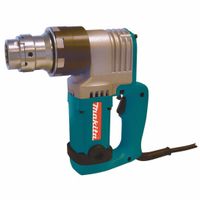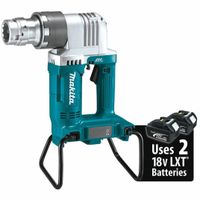Call +(254) 703 030 000 / 751 483 999 / 721 704 777
- Home
- Tools
- Power Tools
- Impact Wrenches Power Torque Wrenches Power Ratchets
- Shear Bolt Wrenches
.....Read More
Frequently Asked Questions
What is a shear bolt wrench?
A shear bolt wrench is a specialized tool designed to install or remove shear bolts, which are fasteners engineered to break at a predetermined torque level. These bolts are commonly used in machinery and equipment to prevent damage by shearing off when excessive force is applied, thus acting as a mechanical fuse. The wrench is typically designed to fit the specific head shape and size of the shear bolt, ensuring proper engagement and torque application.
The wrench often features a socket or a similar gripping mechanism that matches the bolt head, allowing for secure turning. Some shear bolt wrenches may include a torque-limiting feature to prevent over-tightening, ensuring the bolt is installed with the correct amount of force. This is crucial because applying too much torque can prematurely shear the bolt, while insufficient torque may lead to improper fastening.
In addition to standard manual versions, shear bolt wrenches can also be found in powered forms, such as electric or pneumatic tools, which are used in industrial settings for efficiency and ease of use. These powered versions may include adjustable torque settings to accommodate different shear bolt specifications.
Overall, a shear bolt wrench is an essential tool for maintenance and repair tasks involving shear bolts, ensuring they are installed or removed correctly without compromising the integrity of the machinery or equipment they are designed to protect.
How does a shear bolt wrench work?
A shear bolt wrench is a specialized tool designed to install or remove shear bolts, which are used in various mechanical applications to provide a predetermined point of failure under excessive load, protecting more critical components. The wrench works by applying torque to the bolt until the shear section breaks, ensuring the bolt is tightened to the correct specification.
The wrench typically consists of a handle, a socket or head that fits the bolt, and a mechanism to apply torque. When using the wrench, the operator turns the handle, which transfers force to the bolt through the socket. The shear bolt is designed with a specific shear point, a narrowed section that will break when a certain torque is applied. This ensures that the bolt is not over-tightened, which could damage the equipment or compromise safety.
Once the shear point breaks, the head of the bolt separates from the threaded shaft, indicating that the correct torque has been achieved. The wrench may have a built-in feature to catch the broken head, preventing it from falling into machinery or other sensitive areas.
In summary, a shear bolt wrench ensures precise torque application by breaking the bolt at a predetermined point, safeguarding equipment and maintaining operational integrity.
What are the benefits of using a shear bolt wrench?
A shear bolt wrench offers several benefits, particularly in applications where controlled torque is crucial.
1. **Precision and Control**: Shear bolt wrenches are designed to apply a specific amount of torque, ensuring that bolts are tightened to the exact specifications required. This precision helps prevent over-tightening or under-tightening, which can lead to equipment failure or safety hazards.
2. **Safety**: By ensuring that bolts are tightened to the correct torque, shear bolt wrenches reduce the risk of mechanical failures that could lead to accidents or injuries. The shear mechanism prevents excessive force from being applied, protecting both the user and the equipment.
3. **Consistency**: These wrenches provide consistent torque application across multiple bolts, which is essential in maintaining uniformity in assemblies. This consistency is particularly important in industries like construction and manufacturing, where reliability and uniformity are critical.
4. **Efficiency**: Using a shear bolt wrench can speed up the assembly process by eliminating the need for manual torque measurement. Once the shear point is reached, the wrench automatically stops applying force, allowing for quicker and more efficient work.
5. **Durability**: The design of shear bolt wrenches often includes robust materials and construction, making them durable and long-lasting. This durability ensures that they can withstand repeated use in demanding environments.
6. **Cost-Effectiveness**: By preventing damage to bolts and equipment through precise torque application, shear bolt wrenches can reduce maintenance costs and extend the lifespan of machinery.
7. **Ease of Use**: These wrenches are user-friendly, often requiring minimal training to operate effectively. This ease of use makes them accessible to a wide range of users, from professionals to DIY enthusiasts.
Do shear bolt wrenches require calibration?
Yes, shear bolt wrenches require calibration. Calibration ensures that the wrench applies the correct amount of torque to shear the bolt at its designed breaking point. This is crucial for maintaining the integrity and safety of the assembly being worked on. Over time, factors such as wear and tear, mechanical stress, and environmental conditions can affect the accuracy of the wrench. Regular calibration checks help in identifying any deviations from the specified torque settings, ensuring consistent performance and compliance with industry standards. Proper calibration also extends the lifespan of the tool and prevents potential damage to components due to incorrect torque application.
How do you maintain a shear bolt wrench?
To maintain a shear bolt wrench, follow these steps:
1. **Cleaning**: After each use, clean the wrench thoroughly to remove any dirt, grease, or debris. Use a soft cloth or brush and, if necessary, a mild detergent. Ensure all moving parts are free from obstructions.
2. **Inspection**: Regularly inspect the wrench for any signs of wear or damage, such as cracks, bends, or worn-out teeth. Pay special attention to the shear bolt area and the handle.
3. **Lubrication**: Apply a light machine oil to the moving parts of the wrench to ensure smooth operation. Focus on the pivot points and any adjustable components. Wipe off any excess oil to prevent dirt accumulation.
4. **Calibration**: Periodically check the calibration of the wrench to ensure it applies the correct torque. If the wrench is out of calibration, have it professionally adjusted or replaced.
5. **Storage**: Store the wrench in a dry, clean environment to prevent rust and corrosion. Use a tool case or hang it on a pegboard to avoid unnecessary contact with other tools.
6. **Usage**: Use the wrench only for its intended purpose to prevent undue stress and damage. Avoid using excessive force or using the wrench as a hammer or pry bar.
7. **Replacement**: Replace shear bolts and any worn-out parts promptly to maintain the wrench's effectiveness and safety.
By following these maintenance steps, you can extend the life of your shear bolt wrench and ensure it remains reliable and efficient for future use.
What is the difference between a shear bolt wrench and an impact wrench?
A shear bolt wrench and an impact wrench are both tools used for fastening and loosening bolts, but they serve different purposes and operate differently.
A shear bolt wrench is specifically designed for use with shear bolts, which are bolts engineered to break at a predetermined torque level to prevent damage to machinery or equipment. The wrench is typically a manual tool that applies a controlled amount of torque to ensure the bolt shears at the correct point. This type of wrench is used in applications where precise torque control is critical, such as in agricultural machinery or safety devices.
An impact wrench, on the other hand, is a power tool that delivers high torque output with minimal effort from the user. It uses a hammering mechanism to apply sudden, intense rotational force, making it ideal for loosening or tightening stubborn or rusted bolts and nuts. Impact wrenches can be powered by electricity, compressed air, or batteries, and are commonly used in automotive repair, construction, and heavy equipment maintenance.
In summary, the key differences are:
1. Purpose: Shear bolt wrenches are for controlled shearing of specific bolts, while impact wrenches are for general high-torque applications.
2. Operation: Shear bolt wrenches are manual and precise; impact wrenches are powered and deliver high torque.
3. Application: Shear bolt wrenches are used in specialized settings; impact wrenches are versatile and used in various industries.
Can shear bolt wrenches be used for all types of tension-control bolts?
No, shear bolt wrenches cannot be used for all types of tension-control bolts. Tension-control bolts, also known as TC bolts, are specifically designed to be installed using a specialized tool called a shear wrench or TC gun. These bolts have a splined end that is twisted off when the correct tension is achieved, ensuring proper installation.
Shear bolt wrenches are designed to work with TC bolts that have a specific configuration, typically involving a spline and a breakaway section. The wrench grips the spline and applies torque until the spline shears off, indicating that the bolt has reached the desired tension. This method is efficient and ensures consistent tensioning, which is crucial for structural integrity.
However, not all tension-control bolts are identical. Variations in size, design, and manufacturer specifications can affect compatibility with a given shear wrench. Some TC bolts may require different torque settings or have unique features that necessitate a specific type of wrench or adapter. Additionally, other types of bolts, such as standard hex bolts or other proprietary tensioning systems, are not compatible with shear wrenches and require different tools for proper installation.
Therefore, while shear bolt wrenches are effective for many TC bolts, they are not universally applicable to all types. It is essential to ensure that the wrench and the bolts are compatible by consulting the manufacturer's guidelines and specifications for both the tool and the bolts being used. This ensures proper installation and maintains the structural integrity of the assembly.

